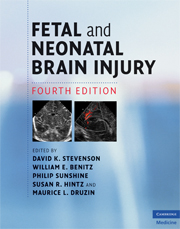Book contents
- Frontmatter
- Contents
- List of contributors
- Foreword
- Preface
- Section 1 Epidemiology, pathophysiology, and pathogenesis of fetal and neonatal brain injury
- Section 2 Pregnancy, labor, and delivery complications causing brain injury
- Section 3 Diagnosis of the infant with brain injury
- Section 4 Specific conditions associated with fetal and neonatal brain injury
- 22 Congenital malformations of the brain
- 23 Neurogenetic disorders of the brain
- 24 Hemorrhagic lesions of the central nervous system
- 25 Neonatal stroke
- 26 Hypoglycemia in the neonate
- 27 Hyperbilirubinemia and kernicterus
- 28 Polycythemia and fetal–maternal bleeding
- 29 Hydrops fetalis
- 30 Bacterial sepsis in the neonate
- 31 Neonatal bacterial meningitis
- 32 Neurological sequelae of congenital perinatal infection
- 33 Perinatal human immunodeficiency virus infection
- 34 Inborn errors of metabolism with features of hypoxic–ischemic encephalopathy
- 35 Acidosis and alkalosis
- 36 Meconium staining and the meconium aspiration syndrome
- 37 Persistent pulmonary hypertension of the newborn
- 38 Pediatric cardiac surgery: relevance to fetal and neonatal brain injury
- Section 5 Management of the depressed or neurologically dysfunctional neonate
- Section 6 Assessing outcome of the brain-injured infant
- Index
- Plate section
- References
31 - Neonatal bacterial meningitis
from Section 4 - Specific conditions associated with fetal and neonatal brain injury
Published online by Cambridge University Press: 12 January 2010
- Frontmatter
- Contents
- List of contributors
- Foreword
- Preface
- Section 1 Epidemiology, pathophysiology, and pathogenesis of fetal and neonatal brain injury
- Section 2 Pregnancy, labor, and delivery complications causing brain injury
- Section 3 Diagnosis of the infant with brain injury
- Section 4 Specific conditions associated with fetal and neonatal brain injury
- 22 Congenital malformations of the brain
- 23 Neurogenetic disorders of the brain
- 24 Hemorrhagic lesions of the central nervous system
- 25 Neonatal stroke
- 26 Hypoglycemia in the neonate
- 27 Hyperbilirubinemia and kernicterus
- 28 Polycythemia and fetal–maternal bleeding
- 29 Hydrops fetalis
- 30 Bacterial sepsis in the neonate
- 31 Neonatal bacterial meningitis
- 32 Neurological sequelae of congenital perinatal infection
- 33 Perinatal human immunodeficiency virus infection
- 34 Inborn errors of metabolism with features of hypoxic–ischemic encephalopathy
- 35 Acidosis and alkalosis
- 36 Meconium staining and the meconium aspiration syndrome
- 37 Persistent pulmonary hypertension of the newborn
- 38 Pediatric cardiac surgery: relevance to fetal and neonatal brain injury
- Section 5 Management of the depressed or neurologically dysfunctional neonate
- Section 6 Assessing outcome of the brain-injured infant
- Index
- Plate section
- References
Summary
Introduction
The term meningitis refers to inflammation of the leptomeninges covering the brain. Bacterial infection of the meninges usually produces a suppurative process or “purulent meningitis.” However, it is probably more correct in the newborn infant to consider the condition as bacterial meningoencephalitis, since it is common to have involvement of the cerebral hemispheres as well as involvement of the meninges.
From the clinician's perspective it has been traditional to think of neonatal sepsis (septicemia) and meningitis together, because the clinical manifestations may be indistinguishable. For many years, the proportion of cases of neonatal sepsis that also had documented meningitis was considered to be one-quarter to one-third. For instance, in 1986 it was estimated that one case of neonatal meningitis occurs for every four cases of sepsis. Indeed, this was my personal experience in Vermont between 1975 and 1980, when 12 of 41 cases (29%) with neonatal sepsis in the first week after birth had associated meningitis. However, in the early 1990s the proportion of cases decreased to as low as 5%. This may be less true in other countries, with 32 of 229 (14%) noted in Israel, 107 of 577 (18.5%) in Panama, and 14 of 84 (17.8%) in Kenya. It is also noteworthy that with meningitis due to Group B Streptococcus (GBS), the proportion of cases may relate to the time of onset of the disease.
- Type
- Chapter
- Information
- Fetal and Neonatal Brain Injury , pp. 347 - 360Publisher: Cambridge University PressPrint publication year: 2009
References
- 1
- Cited by



